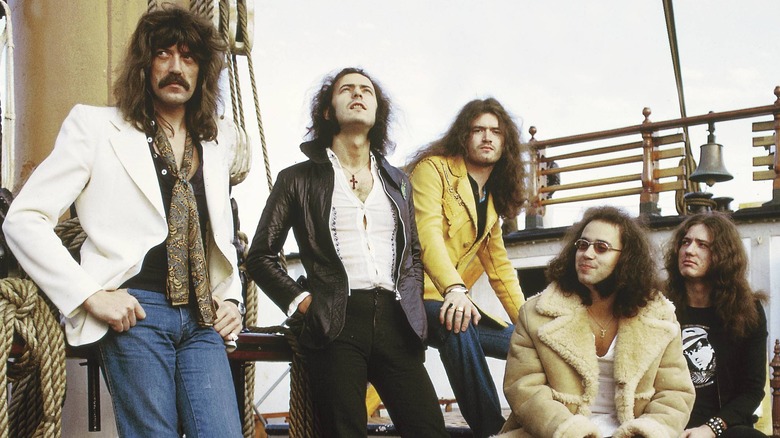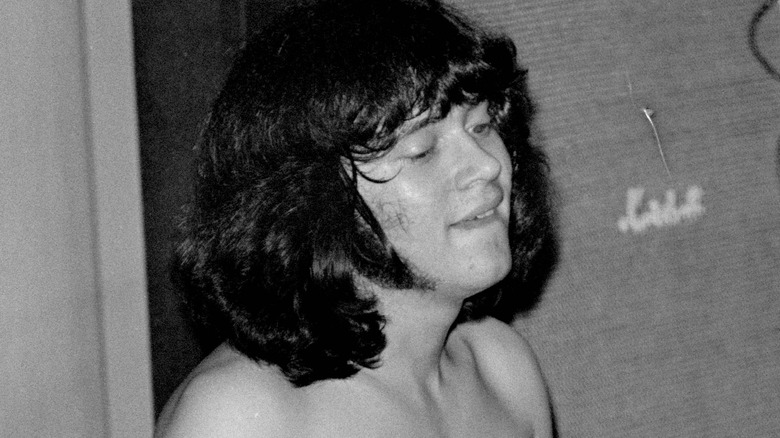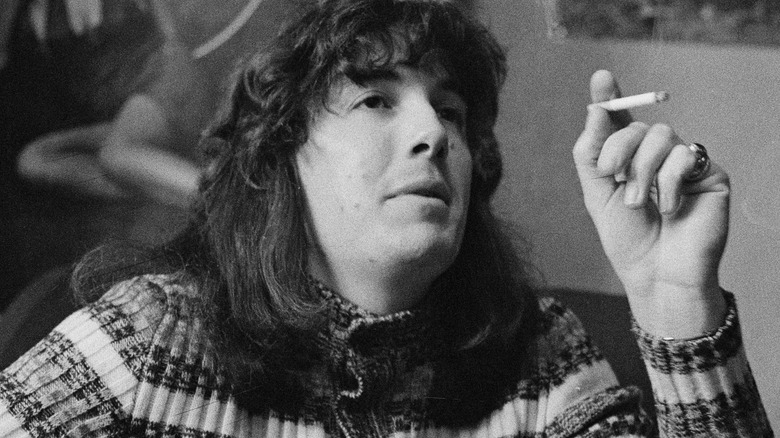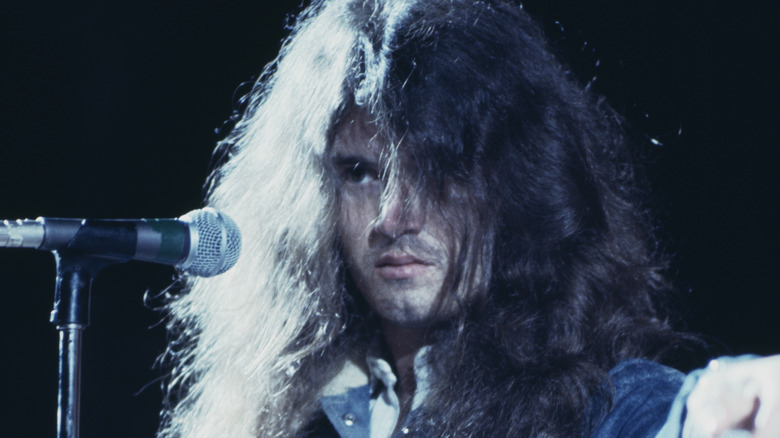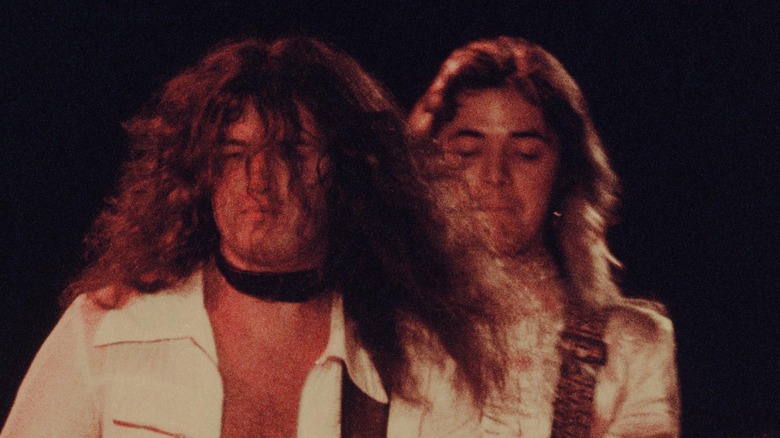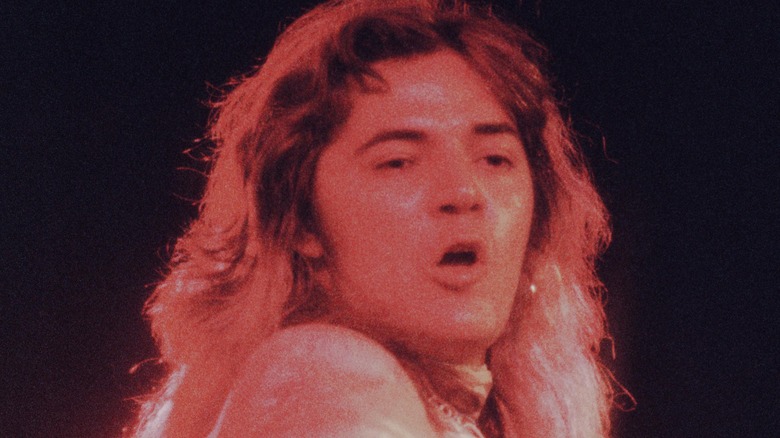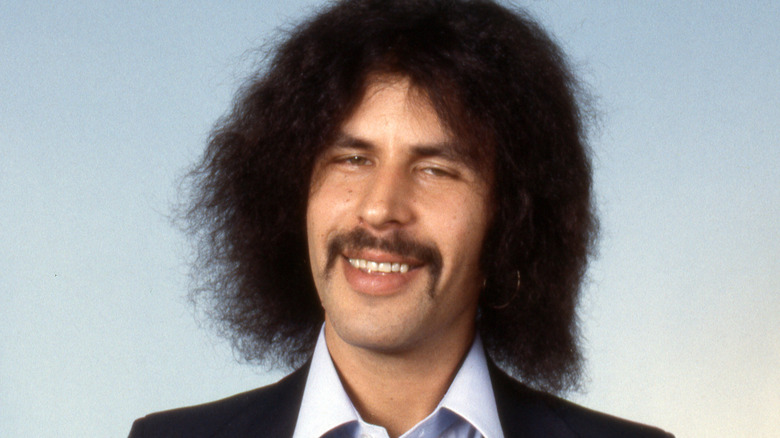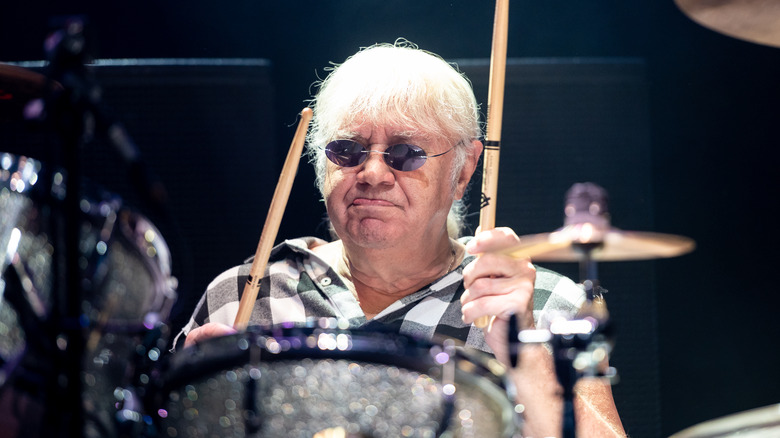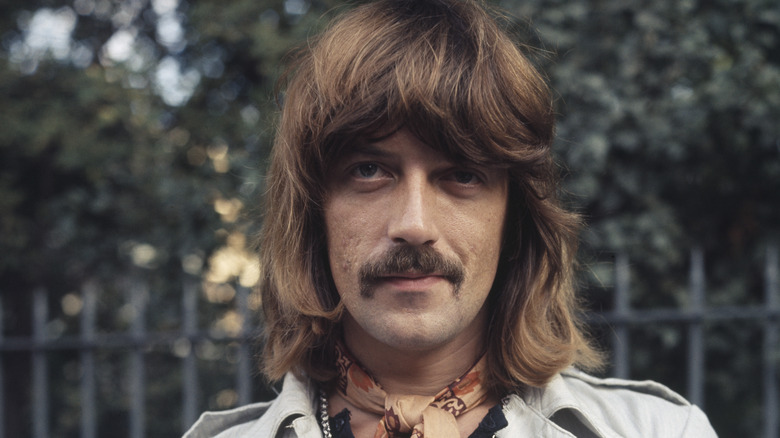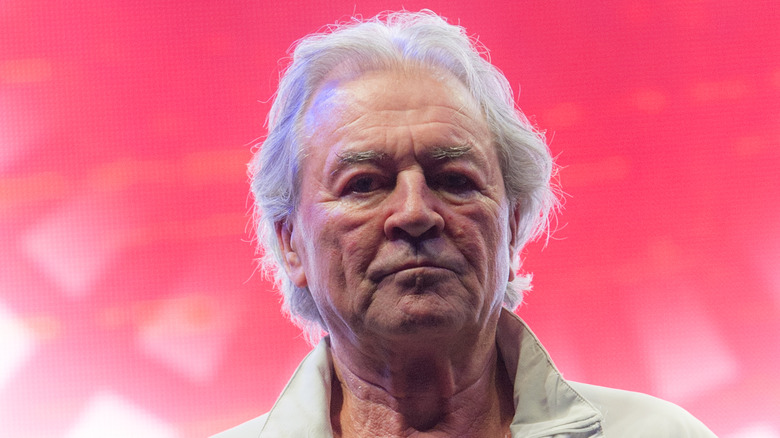Tragic Details About Deep Purple
All the hallmarks of tragedy — danger, destruction, and chaos — were present in the real-life event that Deep Purple would use as fodder to make its best-known song, the 1971 classic rock staple "Smoke on the Water." The band, having arrived in the Swiss resort town of Montreux to record an album, witnessed the central casino complex burn to the ground as the result of a flare gun shot off during a concert by Frank Zappa and the Mothers of Invention. Amidst the mad dash for the exits and subsequent chaos, nobody died, but it was a haunting, core experience for Deep Purple.
The Montreux casino incident wouldn't register as a full-on tragedy for the band, but that didn't mean they always escaped trauma that would alter their lives. As the years wore on, members of Deep Purple would continue to experience the worst of life while trying to churn out hard rock standards like "Hush," "Woman from Tokyo," and "Kentucky Woman."
Ian Paice lost a portion of his lung when he was a child
For years, a bizarre urban legend circulated about founding Deep Purple member Ian Paice — that he had one lung, with doctors surgically removing the other as a result of childhood medical calamity. The rumor persisted in part due to Paice's habit of performing shirtless, allowing fans a glimpse at a large chest scar. The part about a complete lung removal is false; the part about childhood medical trauma is true.
"I have more than one lung. I do not have two lungs. I don't have two complete lungs," Paice explained to Deep Purple Hub (via Deep Purple Fan Forum). In 1954, 6-year-old Paice moved to the United Kingdom with his British parents, having previously lived in Germany due to his father's work post-World War II. "In Germany we were living in a very nice centrally heated apartment, and living very well. When we came back to England we came back to the reality of post-war Britain which was basically bust and broke, and we went to a house where there was no central heating and it was cold and drafty," he said. As a result, Paice developed pneumonia, which worsened to the point where he was diagnosed with tuberculosis — not an easily treatable disease in the 1950s. A resulting surgery took away the infected parts of his left lung, including its lower lobes, and gave him his recognizable scar.
Nick Simper survived a car accident that a bandmate didn't
The original bassist in the foundational Deep Purple lineup in the late 1960s was Nick Simper. His playing can be heard on some of the band's biggest hits, including "Kentucky Woman" and "Hush," and he co-wrote "Wring That Neck." Deep Purple was a prominent but ultimately brief stop in Simper's career, which would also include stints with the Renegades, the Regents, Warhorse, and Fandango. Before he helped form Deep Purple, he played bass for Johnny Kidd and the Pirates. That group, which wore elaborate pirate costumes onstage, started up in the late 1950s and got to the top of the U.K. pop chart or close to it with hits like "Shakin' All Over" and "I'll Never Get Over You."
After some lineup changes and commercial faltering, frontman Johnny Kidd attempted to reboot the band in 1966 as the New Pirates. Simper came on board for that incarnation, but it wouldn't come to pass due to a fatal car accident. In the early morning hours of October 8, 1966, Kidd's car was struck by another vehicle. The at-fault driver was seriously injured, and his passenger was killed. The 30-year-old Kidd also died, with Simper surviving, sustaining a broken arm, broken nose, and superficial injuries. "I sank into deep depression with the date of October 8th 1966 burned deep into my memory," Simper wrote on his website.
Deep Purple's bodyguard died in a violent and mysterious way
Deep Purple toured Asia and Oceania in 1975, and after shows in Hawaii and Australia, the band entertained a request from a concert promoter in Indonesia to squeeze in a Jakarta stop in December. Told they'd play one show at a small theater, Deep Purple discovered they had been booked to play two concerts at Senyan Sports Stadium. About 100,000 came to see the first show, and based on gate receipts, tour manager Rob Cooksey figured that the band earned $750,000. Having received an $11,000 payment, Cooksey confronted the promoter and his cohort. "It started off quite pleasantly and then developed into an argument," Cooksey said in "Deep Purple: The Illustrated Biography," by Chris Charlesworth (via Classic Rock). "Very soon after that there was an incident."
Deep Purple bodyguard Patsy Collins somehow entered an open elevator shaft and fell down six stories. "He fell through these central heating and pipes and water ducts right through into the basement but it didn't kill him instantly," Cooksey recalled. Collins, brutally injured, forced himself into a bus and talked his way into a ride to a hospital, where he died. It remains unclear if Collins' fall was an accident or murder, although Cooksey believes the latter.
Police arrested Cooksey and band member Glenn Hughes, accusing them of murdering Collins. While Hughes was released in time to perform the second show, Cooksey was jailed overnight. The band was essentially forced the play the second show at gunpoint. In the end, the band was swindled, including having to pay bribes to even be able to leave the country.
A 1975 Deep Purple show ended with army dogs attacking fans
In the 1960s, Suharto led a military coup in Indonesia, installed himself as dictator, and then executed hundreds of thousands of suspected communists. When Deep Purple arrived in Jakarta in December 1975, Indonesian troops had just invaded nearby Timor, and terrorists had attacked the Indonesian consulate in Amsterdam. Counter to all the extreme political tension and fear were the thousands of fans who lined the streets to greet Deep Purple, the first Western rock band to play Jakarta.
The first Deep Purple concert was a harbinger of things to come, with a backstage dispute over money leading to the death of the band's bodyguard. But the second show, into which Deep Purple was coerced into doing, ended in violent chaos. The fans, mostly teenagers and young adults, got a little too rowdy over the loud, heavy, and frenetic rock music. Stadium security — members of Suharto's military — responded by setting trained Dobermans into the audience, urging and ordering them to attack, all while brandishing machine guns and flamethrowers. "I saw children being torn apart by dogs," Deep Purple singer and bassist Glenn Hughes told POP (via The Limited Times). "I am sure there were deaths." He later told the Houston Press that the band was only able to fly out of Jakarta after the concerts thanks to bribes. "It was just the worst. And they wanted more money on the plane before we could go," he said. "Machetes were drawn."
Tommy Bolin died from a drug overdose
Deep Purple lost its founding guitarist when Ritchie Blackmore departed the band in 1974. Singer David Coverdale recommended a replacement: Iowa-born guitarist Tommy Bolin, who had played on Billy Cobham's "Spectrum" LP. He passed the audition and would play on Deep Purple's 1975 album "Come Taste the Band."
Bolin's tenure in Deep Purple would end quickly and tragically. On December 3, 1976, Bolin played a solo show in Miami and then engaged in a night of drinking with his roadies at a bar and the hotel rooms of various members of the party. According to a timeline in Tallahassee Democrat shortly after his death, Bolin decided to go to sleep around 2 a.m. the following morning, but around 3 a.m., girlfriend Valoria Monzeglio found Bolin on the bathroom floor of their shared hotel room. (She'd later report that Bolin had taken a fall and struck his head, but no damage consistent with that would show up in an autopsy.) Two roadies carried Bolin back to his bed, and just before 8 a.m., the guitarist was discovered unresponsive. Emergency medical personnel arrived and were unable to revive Bolin.
After conducting an autopsy, and noting bruising on Bolin's arm consistent with those of an intravenous drug user, authorities speculated that Bolin had engaged in two days of drug use, likely heroin. His urine tested positive for morphine, cocaine, alcohol, and lidocaine, with the death officially attributed to over-intoxication via multiple substances. Bolin was 25 years old.
Disease, hospitalizations, and death surround Deep Purple's replacement guitarists
In 1970, Deep Purple was set to play a show in San Antonio, and in preparation, every band member received a flu shot. Guitarist Ritchie Blackmore had an adverse reaction that made him so sick he couldn't go on stage. Promoter Joe Miller recommended a replacement: a local musician he managed named Christopher Cross. That's the same Christopher Cross who, a decade later, would win the four major awards at the Grammys with his ultra-soft-rocking debut album.
Two years later, Blackmore once more fell ill, but far more seriously with a communicable disease. "I had hepatitis and was in the hospital for a couple of months," he told The Guardian. Unable to tour or perform most of his usual Deep Purple duties for that period of time, Randy California filled in for Blackmore on guitar. A collaborator of Jimi Hendrix and frontman for the psychedelic rock group Spirit, California's real last name was Wolf; Hendrix nicknamed the guitarist after his home state. While swimming on a beach on the Hawaiian island of Molokai over the 1997 New Year's holiday, an unexpected and massive wave pulled California and his 12-year-old son underwater. California rescued his son, breaking him free of the riptide, before he was swept into the ocean. His body was never found. The guitarist was 45 years old.
The band had a personal connection to a NASA tragedy
Kalpana Chawla was a massive fan of Deep Purple's music, and when she served as a mission specialist on a 2003 flight on NASA's Space Shuttle Columbia, she brought along two Deep Purple CDs: "Machine Head" and "Purpendicular." Her daily wakeup song in space was the "Machine Head" cut "Space Truckin,'" and during the mission, Chawla emailed with members of Deep Purple.
With the 16-day mission coming to an end, Columbia returned to Earth on February 1, 2003. Catastrophic technical difficulties caused the spacecraft to split apart when it entered the Earth's atmosphere — investigations would later uncover a hole on the left wing that had allowed gasses into the shuttle, causing first sensor failure and then a breakdown of all equipment, after a piece of loosened material struck that wing during launch. All seven crew members onboard Columbia died instantly.
Within an hour of hearing the news about Columbia, and Chawla, Deep Purple composed a song in tribute to the astronaut called "Contact Lost," which became the concluding track on the band's 2003 album "Bananas." "This is a musical version of grieving," vocalist Ian Gillan told The Record. "And it's an important tribute. It's very special because it recognizes great heroes, those people who gave their lives in the interest of pioneering work." Guitarist Steve Morse donated his songwriting royalties to the families of the deceased Columbia astronauts.
Ian Paice had a stroke
During a summer 2016 concert tour, Deep Purple abruptly and without reason canceled several scheduled gigs in Denmark and Sweden. Days later, the band's drummer, Ian Paice, released a statement on the Deep Purple website offering an explanation in order "to stop all the speculation and rumours," he said (via Entertainment Weekly).
The 67-year-old drummer said that it was all his fault, and that the cancellations were due to a serious medical issue. He woke up one morning unable to feel his right side and without the ability to move his right hand. Paice sought treatment at a hospital in Stockholm where doctors diagnosed him with a transient ischemic attack — a small stroke that could be a warning sign of further and more serious medical issues. Scans didn't reveal any damage, but Paice felt the effects for a while, such as a stinging in his right hand and numbness in parts of his face. He'd make a full recovery and will have to take medication for the rest of his life, but he was able to return to drumming after missing his first Deep Purple concerts since 1968.
Jon Lord died from a heart ailment after a cancer diagnosis
Jon Lord was a founding and nearly continuous member of Deep Purple. He played keyboards and organ and composed music for the band from its formation in 1968 until 1976, and then again when it reunited, from 1984 to 2002. On August 9, 2011, the musician posted a stark message on his website. "I would like all my friends, followers, fans, and fellow travelers to know that I am fighting cancer and will therefore be taking a break from performing while getting the treatment and cure," he wrote, of what was officially a pancreatic cancer diagnosis. "I fully expect to be back in good shape next year."
Lord wouldn't ever fully return to music. Less than a year later, in July 2012, he died, officially from a pulmonary embolism, while undergoing ongoing treatments for cancer at the London Clinic. Lord had just marked his 71st birthday in June.
Steve Morse left Deep Purple to care for his wife
Steve Morse left one classic rock band, Kansas, and in 1994, joined another Deep Purple. He'd spend nearly three decades playing guitar for Deep Purple. In March 2022, weeks after playing a few gigs, the band announced by a statement on its Facebook page that Morse would take a leave of absence from performing and touring but would maintain his position as an official part of Deep Purple. The statement described the reason for the sudden absence as a "family matter," which Morse wrote an addendum explaining just what was going on. "My dear wife Janine is currently battling cancer," he said. "At this point, there are so many possible complications and unknowns, that whatever time we have left in our lives, I simply must be there with her."
Less than four months later, with his wife still coping with a serious medical situation, Morse made his temporary exit a permanent one. "We are learning to accept stage 4 aggressive cancer and chemo treatment for the rest of her life," Morse wrote on Deep Purple's Facebook page in July 2022. "We both miss being at shows, but I simply couldn't commit to long, or far away tours, since things can change so quickly at home." Morse gave the rest of his band his blessing to allow his replacement, Simon McBride, to become Deep Purple's full-time guitarist.
The tragic marriage of Deep Purple's Ian Gillan
While making the 1982 album "Magic" for his solo project Gillan, Deep Purple singer Ian Gillan met a woman named Bron, part of a collective of backing singers called the Cucumbers. The two connected over stress and heartbreak. "At the time in question, B was going through a divorce, and I was in a pretty low period of my life," he wrote in "Ian Gillan: The Autobiography of Deep Purple's Lead Singer." Ian and Bron Gillan married in 1984.
Bron Gillan was diagnosed with a heart ailment, and in 1991, she underwent a serious surgery. To mark the event and channel his feelings Ian dedicated his solo song "Don't Hold Me Back" to Bron. "It was about my wife and her heart operation, you know?" he told Something Else Reviews. "She was in hospital at the time, and 'we're breaking into your open heart.'"
In November 2022, Bron Gillan died at the age of 67 in Exeter Hospital in the U.K. Ian Gillan couldn't immediately confirm or acknowledge the news of the death of his wife of 38 years. "It's taken some weeks until I could find the words to dignify her publicity," he wrote on his website in January 2023. "I'm pulling the arrow from my eye whilst trying to follow the light and, getting back on my feet whilst struggling to walk with half of me missing."
